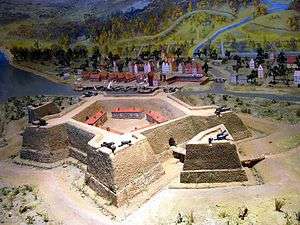Nyenschantz

Nyenschantz (Swedish: Nyenskans, Finnish: Nevanlinna, Russian: Ниенша́нц Nienschanz), often known as Ниен Nien or Канцы Kantsy, was a Swedish fortress built in 1611 at the mouth of the Neva river in Swedish Ingria, on the site of present St. Petersburg, Russia.[1]
History
Nyen was the Swedish name for the Neva river, and officially the fortress was always known as Nyenskans, even though the concepts were in flux in common parlance. The term "skans" is Swedish for "bastion." Near the fortress of Nyenskans a town, Nyen, soon developed which was granted town privileges and became the administrative centre of Swedish Ingria in 1642. According to church records, the town's population was largely Finnish, secondly Swedish, but also some Germans.[2]
In 1656, a Russian attack badly damaged the town, and the administrative centre was moved to Narva.[3] An important Swedish emporium, Nyen was burned down in 1702 in order not to become a threat to the fortress in the event of a Russian invasion.
On May 1, 1703, during the Ingrian campaign of the Great Northern War, the fortress of Nyenskans was taken by Peter the Great and renamed Schlotburg (Shlotburg) (or Sloteburg),[4] "Neck-town", after the long narrow section of the Neva river where it was located (German "Schlot" corresponds to "(funnel) neck, narrows, chimney"). This fortress stood in contrast to Schlüsselburg, "Key-town" (known as "Nöteborg" in Swedish), at the other end of the Neva river. The last Swedish commandant of Nyenskans was Colonel Johan Apolloff, preceded by Colonel Alexander Pereswetoff-Morath (the sons of Russian noblemen, bayors, who had entered Swedish service in the first decades of the 17th century).
Having fallen into Russian hands the fortress functioned only for some weeks, and very soon the tsar founded the fortress and city of Saint Petersburg near the site. Nothing remains of Nyen above ground (as the land has been used for industrial development), but on June 15, 2000 a monument was opened on the site of the fortress, at the mouth of the Okhta river to a design by V. A. Reppo. In the early winter of 2007 remains of the fortress bastions were identified during archaeological excavations, which were necessitated by the threat of irrecoverable exploitation of the entire site.
In May 2003 (on the occasion of the tricentennial of Saint Petersburg), the museum "700 years: Landskrona, the Neva Mouth, Nyenschantz" was opened at the site of the fortress.
See also
References
- ↑ Williams, Harold (1914). Russia of the Russians. Pitman & Sons. p. 33.
- ↑ Carl v. Bonsdorffs; publikation Nyen och Nyenskans. Namn i Nyen på 1600-talet; Names in Nyen's during 1600's
- ↑ Kurs, Ott (1994). Ingria: The broken landbridge between Estonia and Finland. GeoJournal 33.1, 107-113.
- ↑ Cynthia H. Whittaker, E. Kasinec, and Robert H. Davis (eds.), Russia engages the World, 1453-1825, Harvard University Press, 2003; ISBN 0-674-01278-X, 9780674012783.
External links
![]() Media related to Nyenschantz at Wikimedia Commons
Media related to Nyenschantz at Wikimedia Commons
- (Russian) Nyenschanz on the website of the St.Petersburg Diocese gazette
- (Russian) Museum official page
- The Nyenskans Fortress
Coordinates: 59°56′39″N 30°24′25″E / 59.9441666767°N 30.4069444544°E